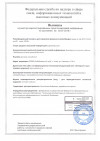Резюме
| Название статьи | МЕТАБОЛИТЫ КИНУРЕНИНОВОГО ПУТИ ОБМЕНА ТРИПТОФАНА В РАЗВИТИИ АНГИОПАТИЙ ПРИ САХАРНОМ ДИАБЕТЕ |
|---|---|
| Title | KYNURENINE PATHWAY METABOLITES OF TRYPTOPHAN METABOLISM IN THE DEVELOPMENT OF ANGIOPATHIES DURING DIABETES MELLITUS |
| Категория | номер 2 за 2023 год (опубликован 10.07.2023) |
| Тип | Обзорная статья |
| Ключевые слова | триптофан, кинурениновый путь, сахарный диабет, ангиопатии |
| Keywords | tryptophan, kynurenine pathway, diabetes mellitus, angiopathy |
| Скачать | Скачать статью |
| doi | 10.52485/19986173_2023_2_173 |
| УДК | 616.379-008.64:577.112.387.4 |
| Резюме | Цель исследования. Обзор современных сведений об участии промежуточных продуктов кинуренинового пути в патогенезе осложнений СД, а именно ангиопатий. Материалы и методы. Выполнен электронный поиск научной литературы в PubMed и Embase, опубликованной до марта 2023 года на предмет статей, в которых сообщалось об особенностях обмена триптофана (TRP), кинуренина (KYN), кинуреновой кислоты (KYNA), ксантуреновой кислоты (XA), антраниловой кислоты (AA) и хинолиновой кислоты (QA) в норме и при сахарном диабете (СД), особое внимание уделялось роли кинуренинов в развитии дисфункции эндотелия. Результаты. Описано влияние многих кинуренинов на углеводный обмен, свободнорадикальные процессы, иммунные реакции, раскрыта их роль в формировании некоторых патологий, в том числе таких, как метаболический синдром, сахарный диабет и его сосудистые осложнения. Заключение. Кинурениновый путь преобразования TRP выполняет несколько важных функций в организме, результаты исследований звеньев его течения постепенно выявляют сложные взаимоотношения между метаболическими нарушениями обмена триптофана, сахарным диабетом и сосудистыми осложнениями. Многие вопросы остаются неизученными, в представленном обзоре литературы намечены некоторые патогенетические взаимосвязи. |
| Список литературы | 1. Badawy A.A. Kynurenine pathway and human systems. Exp. Gerontol. 2020. 129. 110770.DOI10.1016/j.exger.2019.110770. |
| 2. Sas K., Szabo E., Vecsei L. Mitochondria, Oxidative Stress and the Kynurenine System, with a Focus on Ageing and Neuroprotection. Molecules. 2018. 23. 19. DOI10.3390/molecules23010191. | |
| 3. Kiluk M., Lewkowicz J., Pawlak D., Tankiewicz-Kwedlo A. Crosstalk between Tryptophan Metabolism via Kynurenine Pathway and Carbohydrate Metabolism in the Context of Cardio-Metabolic Risk-Review. J Clin Med. 2021. 10(11). 2484. DOI 10.3390/jcm10112484. | |
| 4. Kozie K., Urbanska E.M. Kynurenine Pathway in Diabetes Mellitus-Novel Pharmacological Target? Cells. 2023. 12(3). 460. DOI 10.3390/cells12030460. | |
| 5. Gspr R., Halmi D., Demjn V. et al. Kynurenine Pathway Metabolites as Potential Clinical Biomarkers in Coronary Artery Disease. Front Immunol. 2022. 12. 768560. DOI 10.3389/fimmu.2021.768560. | |
| 6. Liu J.J., Movassat J., Portha B. Emerging role for kynurenines in metabolic pathologies. Curr.Opin. Clin. Nutr. Metab. Care. 2019. 22. 82-90. DOI10.1097/MCO.0000000000000529. | |
| 7. Ala M., Eftekhar S.P. The Footprint of Kynurenine Pathway in Cardiovascular Diseases. Int J Tryptophan Res. 2022. 15. 11786469221096643. DOI 10.1177/11786469221096643. | |
| 8. Moffett J.R., Arun P., Puthillathu N. et al. QUINolinate as a Marker for Kynurenine Metabolite Formation and the Unresolved Question of NAD+ Synthesis During Inflammation and Infection. Front Immunol. 2020. 11. 31. DOI 10.3389/fimmu.2020.00031. | |
| 9. Дедов И.И., Шестакова М.В., Майоров А.Ю. и др. Сахарный диабет 1 типа у взрослых. Сахарный диабет. 2020. 23(1S). 42-114. DOI 10.14341/DM12505. | |
| 10. Sorgdrager F.J.H., Naud P.J.W., Kema I.P. et al. Tryptophan Metabolism in Inflammaging: From Biomarker to Therapeutic Target. Front. Immunol. 2019. 10. DOI10.3389/fimmu.2019.02565. | |
| 11. Ramprasath T., Han Y.M., Zhang D. et al. Tryptophan Catabolism and Inflammation: A Novel Therapeutic Target For Aortic Diseases. Front Immunol. 2021. 12. 731701. DOI 10.3389/fimmu.2021.731701. | |
| 12. Anquetil F., Mondanelli G., Gonzalez N. et al. Loss of IDO1 Expression From Human Pancreatic -Cells Precedes Their Destruction During the Development of Type 1 Diabetes. Diabetes. 2018. 67. 1858-1866. DOI10.2337/db17-1281. | |
| 13. Hughes T.D., Gner O.F., Iradukunda E.C. et al. The Kynurenine Pathway and Kynurenine 3-Monooxygenase Inhibitors. Molecules. 2022. 27(1). 273. DOI 10.3390/molecules27010273 | |
| 14. Мейрамов Г.Г., Конерт К.Д., Мейрамова А.Г. О диабетогенном действии ксантуреновой кислоты. Проблемы Эндокринологии. 2001. 47(1). 39-44. DOI 10.14341/probl11316. | |
| 15. Thirtamara-Rajamani K., Li P., Escobar Galvis M.L. et al. Is the Enzyme ACMSD a Novel Therapeutic Target in Parkinson's Disease? J Parkinsons Dis. 2017. 7(4). 577-587. DOI 10.3233/JPD-171240 | |
| 16. Pelcl T., Skrha J., Prazny M. et al. Diabetes, Cardiovascular Disorders and 2,3,7,8-Tetrachlorodibenzo-p-Dioxin Body Burden in Czech Patients 50 Years After the Intoxication. Basic Clin. Pharmacol. Toxicol. 2018. 123. 356-359. DOI10.1111/bcpt.13013. | |
| 17. Tanabe A., Egashira Y., Fukuoka S. et al. Expression of rat hepatic 2-amino-3-carboxymuconate-6-semialdehyde decarboxylase is affected by a high protein diet and by streptozotocin-induced diabetes. J Nutr. 2002. 132(6). 1153-9. DOI 10.1093/jn/132.6.1153. | |
| 18. Sinclair L.V., Neyens D., Ramsay G. et al. Single cell analysis of kynurenine and System L amino acid transport in T cells. Nat. Commun. 2018. 9. DOI10.1038/s41467-018-04366-7. | |
| 19. Muzik O., Burghardt P., Yi Z. et al. Successful metformin treatment of insulin resistance is associated with down-regulation of the kynurenine pathway. Biochem. Biophys. Res. Commun. 2017. 488. 29-32. DOI10.1016/j.bbrc.2017.04.155. | |
| 20. O’Kell A.L., Wasserfall C., Guingab-Cagmat J. et al. Targeted metabolomic analysis identifies increased serum levels of GABA and branched chain amino acids in canine diabetes. Metabolomics. 2021. 17. 1-13. DOI 10.1007/s11306-021-01850-y. | |
| 21. Oxenkrug G.F. Increased Plasma Levels of Xanthurenic and Kynurenic Acids in Type 2 Diabetes. MolNeurobiol. 2015. 52(2). 805-810. DOI 10.1007/s12035-015-9232-0. | |
| 22. Munipally P.K., Agraharm S.G., Valavala V.K. et al. Evaluation of indoleamine 2,3-dioxygenase expression and kynurenine pathway metabolites levels in serum samples of diabetic retinopathy patients. Arch. Physiol. Biochem. 2011. 117. 254-258. DOI10.3109/13813455.2011.623705. | |
| 23. Debnath S., Velagapudi C., Redus L. et al. Tryptophan Metabolism in Patients with Chronic Kidney Disease Secondary to Type 2 Diabetes: Relationship to Inflammatory Markers. Int. J. Tryptophan Res. 2017. 10. 1178646917694600. DOI 10.1177/1178646917694600. | |
| 24. Wang Q., Ding Y., Song P. et al. Tryptophan-Derived 3-Hydroxyanthranilic Acid Contributes to Angiotensin II-Induced Abdominal Aortic Aneurysm Formation in Mice In Vivo. Circulation. 2017. 136. 2271-83. DOI 10.1161/CIRCULATIONAHA.117.030972. | |
| 25. Kotlinska-Hasiec E., Nowicka-Stazka P., Parada-Turska J. et al. Plasma Kynurenic Acid Concentration in Patients Undergoing Cardiac Surgery: Effect of Anaesthesia. Arch. Immunol. Ther. Exp.2015. 63. 129-137. DOI 10.1007/s00005-014-0312-z. | |
| 26. Liu J.J., Raynal S., Bailbe D. et al. Expression of the kynurenine pathway enzymes in the pancreatic islet cells. Activation by cytokines and glucolipotoxicity.Biochim. Biophys. Acta. 2015. 1852. 980-991. DOI10.1016/j.bbadis.2015.02.001. | |
| 27. Marszalek-Grabska M., Walczak K., Gawel K. et al. Kynurenine emerges from the shadows – Current knowledge on its fate and function. Pharmacol. Ther. 2021. 225. 107845. DOI 10.1016/j.pharmthera.2021.107845. | |
| 28. Yamamoto T., Hatabayashi K., Arita M, et al. Kynurenine signaling through the aryl hydrocarbon receptor maintains the undifferentiated state of human embryonic stem cells. Sci. Signal. 2019. 12. eaaw3306. DOI10.1126/scisignal.aaw3306. | |
| 29. Biljes D., Hammerschmidt-Kamper C., Kadow S. et al. Impaired glucose and lipid metabolism in ageing aryl hydrocarbon receptor deficient mice. EXCLI J. 2015. 14. 1153-1163. DOI10.17179/excli2015-638. | |
| 30. Dabir P., Marinic T.E., Krukovets I. et al. Aryl Hydrocarbon Receptor Is Activated by Glucose and Regulates the Thrombospondin-1 Gene Promoter in Endothelial Cells. Circ. Res. 2008. 102. 1558-1565. DOI10.1161/CIRCRESAHA.108.176990. | |
| 31. Wang Y., Liu H., McKenzie G. et al. Kynurenine is an endothelium-derived relaxing factor produced during inflammation. Nat. Med. 2010. 16. 279-285. DOI10.1038/nm.2092 | |
| 32. Sakakibara K., Feng G.G., Li J. et al. Kynurenine causes vasodilation and hypotension induced by activation of KCNQ-encoded voltage-dependent K(+) channels. J. Pharmacol. Sci. 2015. 129. 31-37. DOI10.1016/j.jphs.2015.07.042. | |
| 33. Ortega D.R., Muiz P.E.U., Ayala T.B. et al. On the Antioxidant Properties of L-Kynurenine: An Efficient ROS Scavenger and Enhancer of Rat Brain Antioxidant Defense. Antioxidants. 2021. 11. 31. DOI 10.3390/antiox11010031 | |
| 34. Kaiser H., Parker E., Hamrick M.W. Kynurenine signaling through the aryl hydrocarbon receptor: Implications for aging and healthspan.Exp. Gerontol. 2020. 130. 110797. DOI 10.1016/j.exger.2019.110797. | |
| 35. Zhen D., Liu J., Zhang X.D., Song Z. Kynurenic Acid Acts as a Signaling Molecule Regulating Energy Expenditure and Is Closely Associated With Metabolic Diseases. Front Endocrinol (Lausanne). 2022. 13. 847611. DOI 10.3389/fendo.2022.847611. | |
| 36. Jung T.W., Park J., Sun J.L. et al. Administration of Kynurenic Acid Reduces Hyperlipidemia-Induced Inflammation and Insulin Resistance in Skeletal Muscle and Adipocytes. Mol Cell Endocrinol. 2020. 518. 110928. DOI 10.1016/j.mce.2020.110928. | |
| 37. Agudelo L.Z., Ferreira D.M.S., Cervenka I. et al. Kynurenic Acid and Gpr35 Regulate Adipose Tissue Energy Homeostasis and Inflammation. Cell Metab. 2018. 27(2). 378-392.e5. DOI10.1016/j.cmet.2018.01.004. | |
| 38. Pyun D.H., Kim T.J., Kim M.J. et al. Endogenous Metabolite, Kynurenic Acid, Attenuates Nonalcoholic Fatty Liver Disease viaAMPK/autophagy- and AMPK/ORP150-Mediated Signaling. J Cell Physiol. 2021. 236(7). 4902-12. DOI 10.1002/jcp.30199. | |
| 39. Stone T.W., Stoy N., Darlington L.G. An expanding range of targets for kynurenine metabolites of tryptophan. Trends Pharmacol Sci. 2013. 34(2). 136-43. DOI 10.1016/j.tips.2012.09.006. | |
| 40. Wang L., Cheng B., Ju Q., Sun B.K. AhR Regulates Peptidoglycan-Induced Inflammatory Gene Expression in Human Keratinocytes. J Innate Immun. 2022. 14(2). 124-134. DOI 10.1159/000517627 | |
| 41. Cole J.E., Astola N., Cribbs A.P. et al. Indoleamine 2,3-dioxygenase-1 is protective in atherosclerosis and its metabolites provide new opportunities for drug development. Proc. Natl. Acad. Sci. USA. 2015. 112. 13033-13038. DOI 10.1073/pnas.1517820112. | |
| 42. Jamshed L., Debnath A., Jamshed S. et al. An Emerging Cross-Species Marker for Organismal Health: Tryptophan-Kynurenine Pathway. Int J Mol Sci. 2022. 23(11). 6300. DOI 10.3390/ijms23116300. | |
| 43. Goldstein L.E., Leopold M.C., Huang X. et al. 3-Hydroxykynurenine and 3-hydroxyanthranilic acid generate hydrogen peroxide and promote alpha-crystallin cross-linking by metal ion reduction. Biochemistry. 2000. 39(24). 7266-75. DOI 10.1021/bi992997s. | |
| 44. Fazio F., Carrizzo A., Lionetto L. et al. Vasorelaxing Action of the Kynurenine Metabolite, Xanthurenic Acid: The Missing Link in Endotoxin-Induced Hypotension? Front Pharmacol. 2017. 8. 214. DOI 10.3389/fphar.2017.00214. | |
| 45. Kalaska B., Ciborowski M., Domaniewski T. et al. Serum metabolic fingerprinting after exposure of rats to QUINolinic acid. J. Pharm. Biomed. Anal. 2016. 131. 175-182. DOI10.1016/j.jpba.2016.08.024. | |
| 46. Chen T., Zheng X., Ma X. et al. Tryptophan Predicts the Risk for Future Type 2 Diabetes. PLoSONE. 2016. 11. e0162192. DOI 10.1371/journal.pone.0162192. | |
| 47. Литвинов Р.А., Гонтарева А.В., Усмиянова Л.Э., Клименко Д.Р. Влияние некоторых D-металлов на образование конечных продуктов гликирования, агрегацию и амилоидную трансформацию альбумина в реакции гликирования. Фармация и фармакология. 2021. 9(4):306-317. DOI.10.19163/2307-9266-2021-9-4-306-317 | |
| Resume | Objective. To review current data about the participation of kynurenine pathway’s intermediate products in the pathogenesis of complications of diabetes, namely angiopathy. Materials and methods. There was an electronic research of the scientific literature in PubMed and Embase published up to March 2023 for articles that reported on the features of the metabolism of tryptophan (TRP), kynurenine (KYN), kynurenic acid (KYNA), xanthurenic acid (XA), anthranilic acid (AA) and QUINoline acid (QA) in normal state and during diabetes mellitus (DM). Special attention was paid to the role of kynurenines in the development of endothelial dysfunction. Results. A descriptive research of the variety of kynurenines’ influence on carbohydrate metabolism, free radical processes, immune responses is described, as well as their role in the formation of some pathologies, including metabolic syndrome, diabetes mellitus and its vascular complications, is presented. Conclusion. The kynurenine pathway of TRP conversion performs several important functions in the body; the results of studies of its course features gradually reveal the complicated relationship between metabolic disorders of tryptophan metabolism, diabetes mellitus and vascular complications. Many issues remain unexplored; some pathogenetic relationships are outlined in currnet literature review. |
| Автор 1 | Фефелова Елена Викторовна |
| Автор 2 | Саклакова Ольга Алексеевна |
| Автор 3 | Максименя Мария Владимировна |
| Автор 4 | Коцюржинская Наталья Николаевна |
| Автор 5 | Караваева Татьяна Михайловна |
| Автор 6 | Терешков Павел Петрович |



